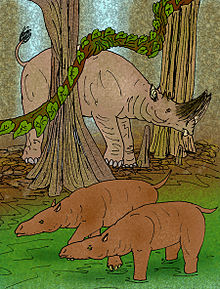
The lagomorphs are the members of the taxonomic order Lagomorpha, of which there are two living families: the Leporidae and the Ochotonidae (pikas). There are 110 recent species of lagomorph of which 109 are extant, including 10 genera of rabbits, 1 genus of hare and 1 genus of pika. The name of the order is derived from the Ancient Greek lagos + morphē.

Barn-owls are one of the two families of owls, the other being the true owls or typical owls, Strigidae. They are medium to large owls with large heads and characteristic heart-shaped faces. They have long, strong legs with powerful talons. They also differ from the Strigidae in structural details relating in particular to the sternum and feet.

Struthionidae is a family of flightless birds, containing the extant ostriches and their extinct relatives. The two extant species of ostrich are the common ostrich and Somali ostrich, both in the genus Struthio, which also contains several species known from Holocene fossils such as the Asian ostrich. The common ostrich is the more widespread of the two living species, and is the largest living bird species. The extinct genus Pachystruthio from the Late Pliocene-Early Pleistocene of Eurasia is one of the largest birds ever.
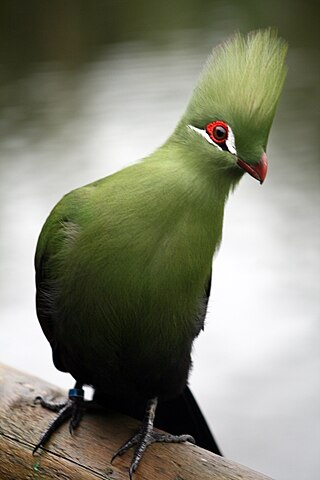
The turacos make up the bird family Musophagidae ( "banana-eaters"), which includes plantain-eaters and go-away-birds. In southern Africa both turacos and go-away-birds are commonly known as loeries. They are semi-zygodactylous: the fourth (outer) toe can be switched back and forth. The second and third toes, which always point forward, are conjoined in some species. Musophagids often have prominent crests and long tails; the turacos are noted for peculiar and unique pigments giving them their bright green and red feathers.

The mousebirds are birds in the order Coliiformes. They are the sister group to the clade Cavitaves, which includes the Leptosomiformes, Trogoniformes (trogons), Bucerotiformes, Piciformes and Coraciformes. This group is now confined to sub-Saharan Africa, and it is the only bird order confined entirely to that continent, with the possible exception of turacos which are considered by some as the distinct order Musophagiformes, and the cuckoo roller, which is the only member of the order Leptosomiformes, and which is found in Madagascar but not mainland Africa. Mousebirds had a wider range in the Paleogene, with a widespread distribution in Europe and North America during the Paleocene.

The Lacertidae are the family of the wall lizards, true lizards, or sometimes simply lacertas, which are native to Afro-Eurasia. It is a diverse family with at about 360 species in 39 genera. They represent the dominant group of reptiles found in Europe.
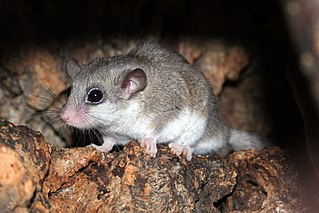
A dormouse is a rodent of the family Gliridae. Dormice are nocturnal animals found in Africa, Asia, and Europe. They are named for their long, dormant hibernation period of six months or longer.

Ostriches are large flightless birds. Two living species are recognised, the common ostrich, native to large areas of sub-Saharan Africa, and the Somali ostrich, native to the Horn of Africa.

Moeritherium is an extinct genus of basal proboscideans from the Eocene of North and West Africa. It was related to elephants and, more distantly, to sea cows and hyraxes.
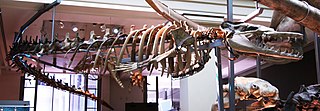
Basilosaurus is a genus of large, predatory, prehistoric archaeocete whale from the late Eocene, approximately 41.3 to 33.9 million years ago (mya). First described in 1834, it was the first archaeocete and prehistoric whale known to science. Fossils attributed to the type species B. cetoides were discovered in the United States. They were originally thought to be of a giant reptile, hence the suffix "-saurus", Ancient Greek for "lizard". The animal was later found to be an early marine mammal, prompting attempts at renaming the creature, which failed as the rules of zoological nomenclature dictate using the original name given. Fossils were later found of the second species, B. isis, in 1904 in Egypt, Western Sahara, Morocco, Jordan, Tunisia, and Pakistan. Fossils have also been unearthed in the southeastern United States and Peru.
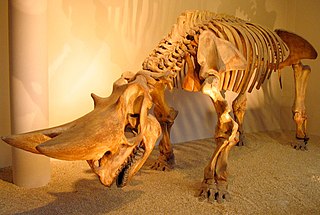
Embrithopoda ("heavy-footed") is an order of extinct mammals known from Asia, Africa and Eastern Europe. Most of the embrithopod genera are known exclusively from jaws and teeth dated from the late Paleocene to the late Eocene; however, the order is best known from its terminal member, the elephantine Arsinoitherium.
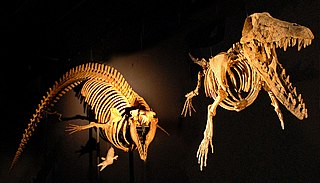
Archaeoceti, or Zeuglodontes in older literature, is a paraphyletic group of primitive cetaceans that lived from the Early Eocene to the late Oligocene. Representing the earliest cetacean radiation, they include the initial amphibious stages in cetacean evolution, thus are the ancestors of both modern cetacean suborders, Mysticeti and Odontoceti. This initial diversification occurred in the shallow waters that separated India and Asia 53 to 45 mya, resulting in some 30 species adapted to a fully oceanic life. Echolocation and filter-feeding evolved during a second radiation 36 to 35 mya.
Armintomys is an extinct genus of rodent from North America related to jerboas and jumping mice. It is the only genus in the family Armintomyidae. It lived during the early Eocene, and is the oldest known example of a hystricomorphous zygomasseteric dentition. In addition, Armintomys is also the oldest known rodent that had an incisor enamel transition from pauciserial to uniserial. Its remains have only been found in the Wind River Basin in Wyoming, and could be found there during the species' existence on Earth. It was previously assumed that Armintomys belonged to the Dipodoidea family, but has since been understood to have been part of an early radiation of dipodoid rodents, but was not directly ancestral to any later dipodoids, thus it was recategorized into its own family.
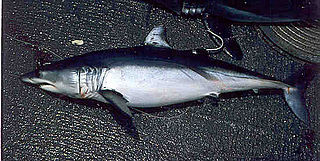
Isurus is a genus of mackerel sharks in the family Lamnidae, commonly known as the mako sharks. They are largely pelagic, fast predatory fish capable of swimming at speeds up to 50 km/h (31 mph).

Palaeoryctidae is an extinct family of non-specialized eutherian mammals from extinct order Palaeoryctida, that lived in North America, Europe, Asia and Africa from the late Cretaceous to middle Eocene.
Parapithecidae is an now extinct family of primates which lived in the Eocene and Oligocene periods in Egypt. Eocene fossils from Myanmar are sometimes included in the family in addition. They showed certain similarities in dentition to Condylarthra, but had short faces and jaws shaped like those of tarsiers. They are part of the superfamily Parapithecoidea, perhaps equally related to Ceboidea and Cercopithecoidea plus Hominoidea - but the placement of Parapithecoidea is substantially uncertain.
Djebelemur is an extinct genus of early strepsirrhine primate from the late early or early middle Eocene period from the Chambi locality in Tunisia. Although they probably lacked a toothcomb, a specialized dental structure found in living lemuriforms, they are thought to be a related stem group. The one recognized species, Djebelemur martinezi, was very small, approximately 100 g (3.5 oz).
Djebelemuridae is an extinct family of early strepsirrhine primates from Africa. It consists of five genera. The organisms in this family were exceptionally small, and were insectivores. This family dates to the early to late Eocene. Although they gave rise to the crown strepsirrhines, which includes today's lemurs and lorisoids, they lacked the toothcomb that identifies that group.
Plesiopithecus is an extinct genus of early strepsirrhine primate from the late Eocene.

Afrotarsius is a primate found in the Paleogene of Africa.
